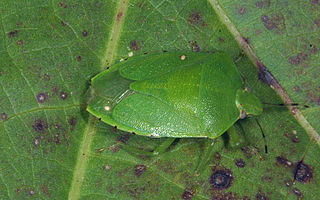
The green stink bug or green soldier bug is a stink bug of the family Pentatomidae.

The brown marmorated stink bug is an insect in the family Pentatomidae, native to China, Japan, Korea, and other Asian regions. In September 1998, it was collected in Allentown, Pennsylvania, where it is believed to have been accidentally introduced. The nymphs and adults of the brown marmorated stink bug feed on over 100 species of plants, including many agricultural crops, and by 2010–11 had become a season-long pest in orchards in the Eastern United States. In 2010, in the Mid-Atlantic United States, $37 million in apple crops were lost, and some stone fruit growers lost more than 90% of their crops. Since the 2010s, the bug has spread to the nation of Georgia and Turkey and caused extensive damage to hazelnut production. It is now established in many parts of North America, and has recently become established in Europe and South America.

Peridroma saucia, the pearly underwing or variegated cutworm, is a moth of the family Noctuidae. The species was first described by Jacob Hübner in 1808. It is found in North and South America, Europe, Asia and Africa. The variegated cutworm feeds on many plants, especially common fruits and vegetables. The moth undergoes two to four generations per year. The development of the moth slows in colder temperatures, indicative of its migratory nature. All stages of the life cycle have a developmental threshold for temperature. The moth is known to migrate to the northern regions during warmer months, returning to the southern regions when the climate becomes colder.
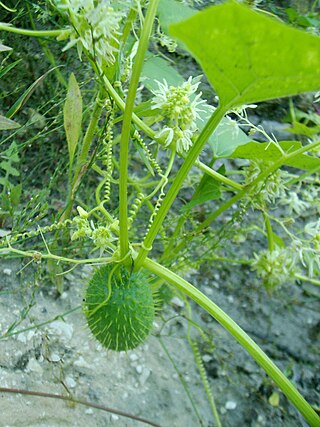
Echinocystis is a monotypic genus in the gourd family, Cucurbitaceae. The sole species is E. lobata, commonly called wild cucumber, prickly cucumber or bur cucumber. It is an annual, sprawling plant that is native to North America.

Nezara viridula, commonly known as the southern green stink bug (USA), southern green shield bug (UK) or green vegetable bug, is a plant-feeding stink bug. Believed to have originated in Ethiopia, it can now be found across the world. Because of its preference for certain species of legumes, such as beans and soybeans, it is an economically important pest on such crops.

Trissolcus japonicus, the samurai wasp, is a parasitoid wasp species in the family Scelionidae, native to east Asia but now found in Europe, North America, and Chile. It is chiefly known for parasitizing Halyomorpha halys. It deposits eggs into the eggs of the stink bug, and as the wasp larvae develop, they kill the stink bug eggs. A single adult wasp emerges from each stink bug egg.

Aphis craccivora, variously known as the cowpea aphid, groundnut aphid or black legume aphid, is a true bug in the family Aphididae. Originally of probable Palearctic origin, it is now an invasive species of cosmopolitan distribution.

Euthyrhynchus floridanus, the Florida predatory stink bug, is a species of carnivorous shield bug in the family Pentatomidae, the only species in the genus Euthyrhynchus. It is native to the hottest parts of the southeastern United States and is considered beneficial because it feeds on many species of pest insects. They also feed on things such as grasshoppers and other small insects. This species also hunts in a pack, with up to twelve.

Telenomus podisi is a species of egg parasitoid wasps described by William Harris Ashmead in 1893 and placed in the family of Platygastridae. It is a parasitoid of the brown stink bug, Euschistus heros and can be raised in labs on the eggs of Cosmopepla lintneriana, Podisus maculiventris, and Euschistus servus. This wasp can be used in integrated pest management to control E. heros. The insecticide Imidacloprid is lethal for these wasps, and other insecticides have been shown to negatively impact rates of egg parasitism.
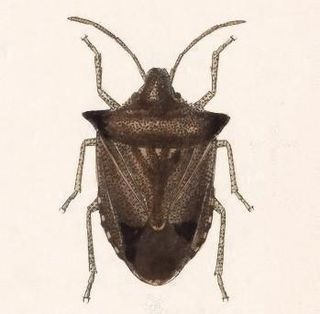
Euschistus is a genus of stink bugs in the family Pentatomidae. There are at least 20 described species in Euschistus.
Euschistus latimarginatus is a species of stink bug in the family Pentatomidae. It is found in North America.
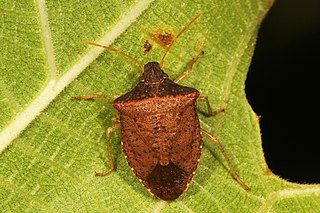
Euschistus obscurus, the pale-lined stink bug, is a species of stink bug in the family Pentatomidae. It is found in the Caribbean Sea, Central America, and North America.

Euschistus crassus is a species of stink bug in the family Pentatomidae. It is found in the Caribbean Sea and North America.
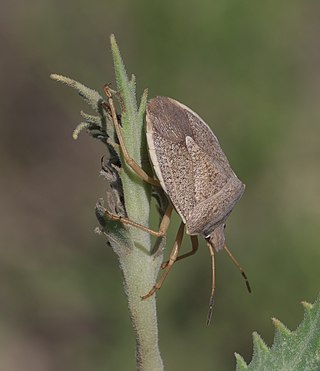
Euschistus variolarius, the one-spotted stink bug, is a species of stink bug in the family Pentatomidae. It is found in the Caribbean Sea and North America.

Euschistus tristigmus, the dusky stink bug, is a species of stink bug in the family Pentatomidae. It is found in Central America and North America.
Euschistus politus is a species of stink bug in the family Pentatomidae. It is found in North America.

Euschistus inflatus is a species of stink bug in the family Pentatomidae. It is found in North America.

Euschistus acuminatus is a species of stink bug in the family Pentatomidae. It is found in the Caribbean Sea and North America.

Euschistus strenuus is a species of stink bug in the family Pentatomidae. It is found in Central America and North America.

Proxys punctulatus, the black stink bug, is a species of stink bug in the family Pentatomidae. It is found in the Caribbean Sea, Central America, and North America.



















